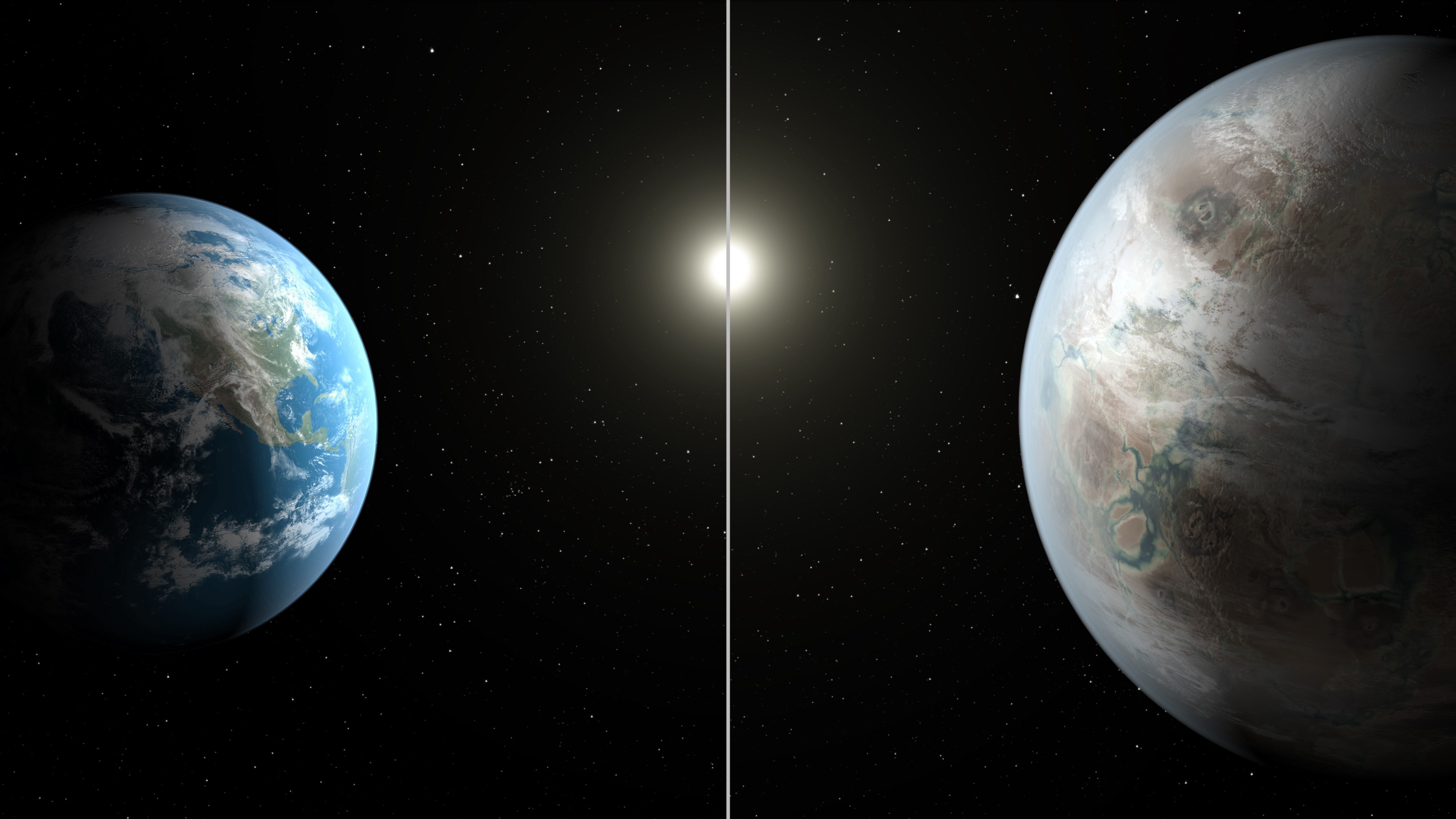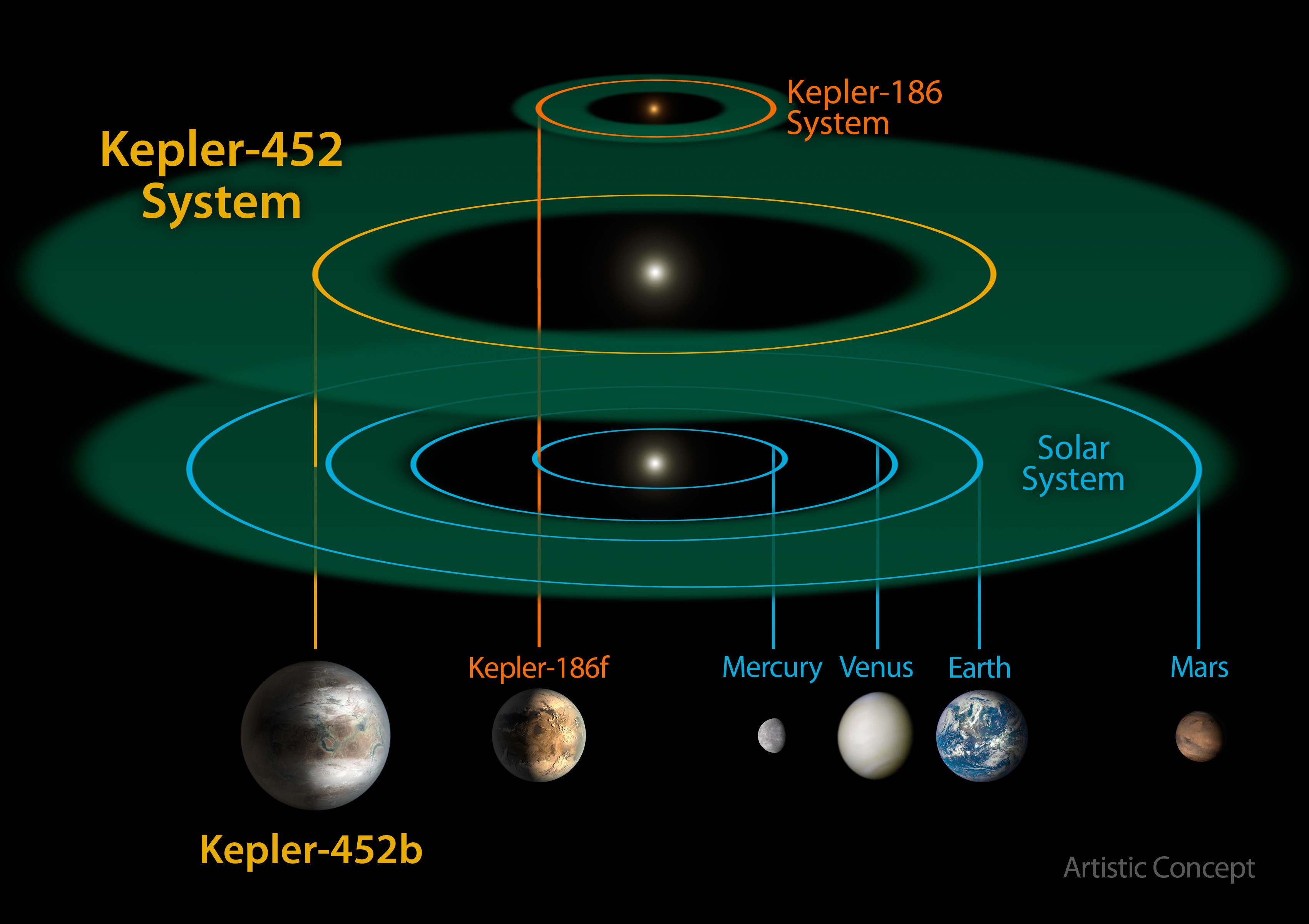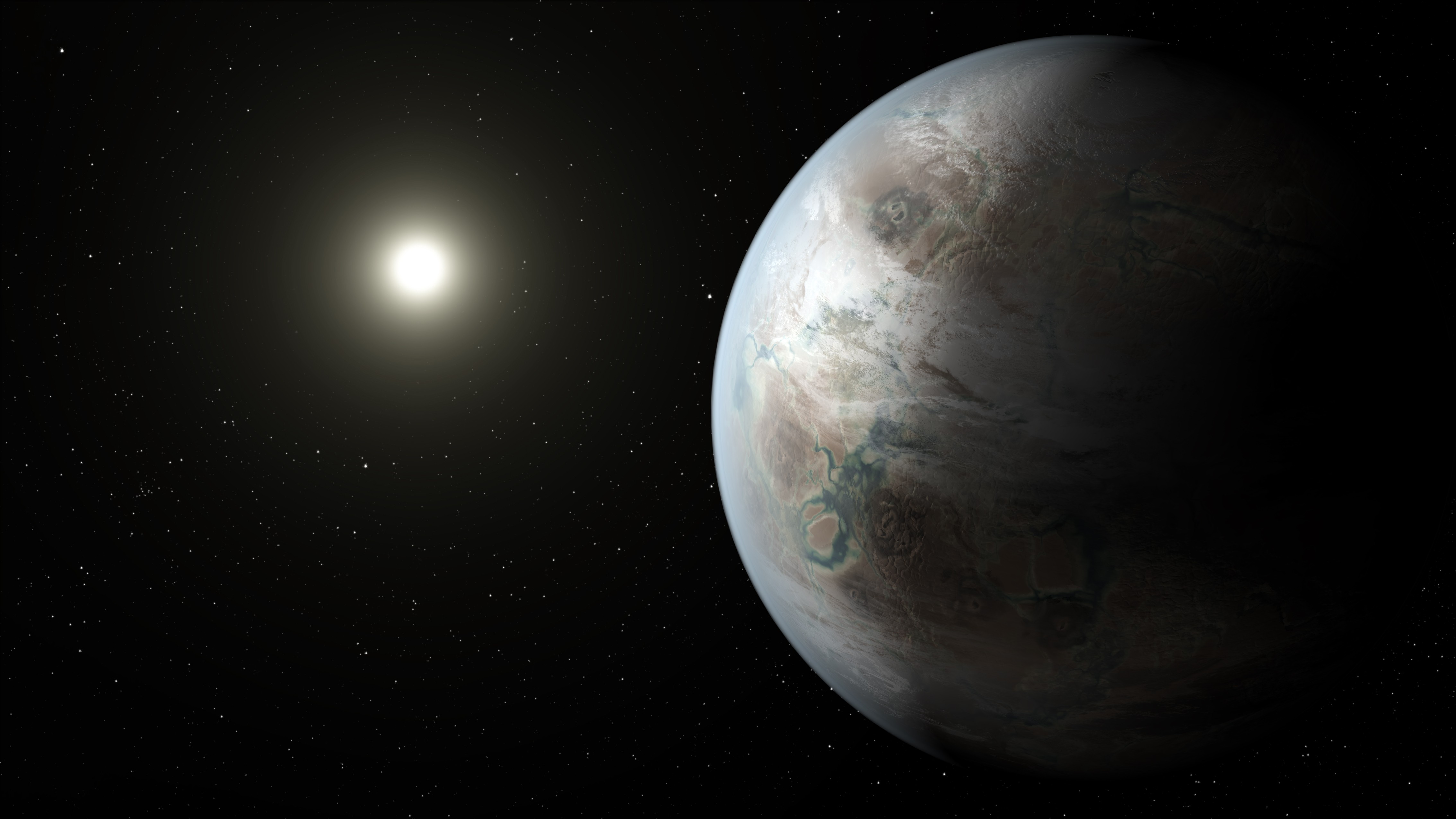Kepler-452b Size Comparison to Earth is a frequent search, reflecting the high public interest in understanding exoplanets. At COMPARE.EDU.VN, we provide a comprehensive comparison of Kepler-452b and Earth, highlighting their size, orbit, and potential habitability, offering clarity to your search. Explore stellar systems and planetary sizes with confidence.
1. Introduction: Unveiling Kepler-452b
The quest to find another Earth has captivated scientists and space enthusiasts alike. Among the many exoplanets discovered, Kepler-452b stands out as a particularly intriguing candidate. Often dubbed “Earth’s Cousin” or “Earth 2.0”, this planet orbits a star similar to our Sun and resides within the habitable zone, where liquid water could potentially exist. But the burning question remains: How big is Kepler-452b compared to Earth? This article delves into the specifics of Kepler-452b, comparing its size, characteristics, and potential for habitability with our home planet, Earth. This detailed comparison, tailored for a broad audience, will shed light on why Kepler-452b holds such a prominent place in the search for life beyond Earth.
2. Kepler-452b: A Distant Cousin
Kepler-452b was discovered by NASA’s Kepler Space Telescope, a mission dedicated to finding Earth-sized planets orbiting other stars. The discovery, announced in 2015, marked a significant milestone in the search for potentially habitable worlds. Located approximately 1,400 light-years away in the constellation Cygnus, Kepler-452b orbits a G2-type star, much like our Sun.
2.1. Vital Statistics
Before diving into the size comparison, let’s establish some key facts about Kepler-452b:
- Diameter: Approximately 60% larger than Earth.
- Orbit: Completes one orbit around its star in 385 days.
- Star Type: G2-type, similar to our Sun.
- Distance from Star: Roughly the same distance as Earth is from the Sun.
- Location: 1,400 light-years away in the constellation Cygnus.
- Age of Star: Approximately 6 billion years old (1.5 billion years older than our Sun).
These characteristics make Kepler-452b particularly interesting in the context of habitability. Its star is similar to our Sun, and its orbital period is close to Earth’s, suggesting potentially similar conditions.
3. How Big Is Kepler-452b Compared To Earth? A Detailed Analysis
The core question is: how does Kepler-452b’s size stack up against Earth’s? While we don’t have precise measurements of its mass and density, we know that Kepler-452b is about 60% larger in diameter than Earth. This places it in a category of planets known as “super-Earths.”
3.1. Understanding the Size Difference
To visualize the size difference, imagine Earth having a diameter of 1. If that were the case, Kepler-452b would have a diameter of approximately 1.6. This means that if you were to walk around the equator of Kepler-452b, you would travel 60% further than if you walked around Earth’s equator.
3.2. Implications of the Size Difference
The larger size of Kepler-452b has several potential implications:
- Gravity: A larger planet likely has stronger gravity. This could affect the atmosphere, the ability of the planet to retain water, and potentially even the evolution of life.
- Atmosphere: The stronger gravity could result in a denser atmosphere, which could significantly alter the planet’s temperature and climate.
- Geology: The internal geology of a larger planet could be different from Earth’s, potentially affecting plate tectonics, volcanic activity, and the planet’s magnetic field.
- Surface Area: A larger diameter significantly increases the surface area available for potential life.
3.3. Visual Comparison
The following table provides a direct comparison of key characteristics between Earth and Kepler-452b:
| Feature | Earth | Kepler-452b |
|---|---|---|
| Diameter | 12,742 km | ~20,387 km (est.) |
| Relative Size | 1x | ~1.6x |
| Orbital Period | 365.25 days | 385 days |
| Star Type | G2V | G2 |
| Distance from Star | 1 AU | ~1.05 AU |
| Star Age | 4.5 billion years | 6 billion years |



This image provides an artistic concept comparing Earth (left) to Kepler-452b (right), illustrating the size difference. Scientists do not currently know whether Kepler-452b has oceans and continents like Earth.
4. Super-Earths: What We Know
Kepler-452b belongs to a class of exoplanets known as “super-Earths.” These planets are more massive than Earth but substantially less massive than the gas giants in our solar system, such as Neptune and Uranus.
4.1. Characteristics of Super-Earths
Super-Earths are a diverse group, and their properties can vary widely. Some key characteristics include:
- Mass: Typically between 1 and 10 times the mass of Earth.
- Radius: Generally larger than Earth but smaller than Neptune.
- Composition: Could be rocky, gaseous, or a combination of both.
- Atmosphere: Can range from thick and dense to thin or non-existent.
4.2. Potential for Habitability
The habitability of super-Earths is a topic of ongoing research. Their larger size could present both advantages and disadvantages for the development of life:
-
Advantages:
- More Surface Area: A larger surface area provides more space for life to potentially emerge and thrive.
- Potential for Liquid Water: Depending on the atmosphere and distance from the star, super-Earths could potentially support liquid water on their surface.
-
Disadvantages:
- Stronger Gravity: The increased gravity could make it difficult for complex life forms to evolve.
- Dense Atmosphere: A very dense atmosphere could lead to extreme temperatures and pressures, making the surface uninhabitable.
4.3. Factors Affecting Habitability
Several factors determine whether a super-Earth, including Kepler-452b, could be habitable:
- Distance from the Star: The planet must be located within the habitable zone, where temperatures are suitable for liquid water.
- Atmospheric Composition: The atmosphere must be conducive to life, providing protection from harmful radiation and maintaining a stable temperature.
- Presence of Water: Liquid water is considered essential for life as we know it.
- Magnetic Field: A magnetic field can protect the planet from harmful solar winds.
- Geological Activity: Plate tectonics and volcanic activity can help regulate the planet’s temperature and cycle nutrients.
5. The Kepler-452 System Compared To Our Solar System
To further understand Kepler-452b, it’s helpful to compare its system to our own solar system. Kepler-452b orbits a G2-type star that is similar to our Sun but slightly older, larger, and brighter.
5.1. Star Comparison
| Feature | Sun | Kepler-452 |
|---|---|---|
| Type | G2V | G2 |
| Age | 4.5 billion years | 6 billion years |
| Diameter | 1.39 million km | ~1.53 million km |
| Brightness | 1x | ~1.2x |
| Temperature | 5,778 K | Similar |
Kepler-452 is about 10% larger in diameter and 20% brighter than our Sun. This means that Kepler-452b receives slightly more energy from its star than Earth does from the Sun.
5.2. System Architecture
While we don’t know the complete architecture of the Kepler-452 system, we do know that Kepler-452b is the only confirmed planet in the system. It’s possible that there are other planets orbiting the star, but they have not yet been detected.
5.3. Implications of an Older Star
The fact that Kepler-452 is older than our Sun has significant implications for Kepler-452b:
- Increased Luminosity: As stars age, they become brighter and hotter. This means that Kepler-452b has likely experienced a gradual increase in the amount of energy it receives from its star over billions of years.
- Runaway Greenhouse Effect: If Kepler-452b originally had liquid water on its surface, the increased luminosity of its star could have caused a runaway greenhouse effect, leading to the evaporation of the water and a very hot, uninhabitable surface. This is similar to what happened to Venus in our solar system.
- Potential for Past Habitability: On the other hand, the planet may have been habitable in the past, when the star was younger and less luminous.
This image compares the size and scale of the Kepler-452 system alongside the Kepler-186 system and our solar system. Note the similarity in the habitable zone between Kepler-452 and the Sun.
6. The Search for Life on Kepler-452b
Given its location in the habitable zone and its Earth-like characteristics, Kepler-452b has become a prime target in the search for extraterrestrial life.
6.1. Challenges in Studying Kepler-452b
Studying Kepler-452b presents several challenges:
- Distance: At 1,400 light-years away, it’s incredibly difficult to obtain detailed observations of the planet.
- Size: As a relatively small exoplanet, it’s difficult to detect its atmosphere and surface features.
- Lack of Information: We don’t know the planet’s mass, density, or atmospheric composition.
6.2. Future Missions
Despite the challenges, scientists are developing new technologies and missions to study exoplanets like Kepler-452b in more detail. Some of the upcoming missions that could potentially provide more information include:
- James Webb Space Telescope (JWST): This powerful telescope, launched in 2021, is capable of studying the atmospheres of exoplanets in detail.
- Nancy Grace Roman Space Telescope: This telescope, scheduled to launch in the mid-2020s, will be able to detect thousands of new exoplanets and study their properties.
6.3. What We Hope To Learn
By studying Kepler-452b and other exoplanets, scientists hope to answer some fundamental questions:
- Is there life beyond Earth?
- What are the conditions necessary for life to arise?
- How common are Earth-like planets in the universe?
- What is the future of life on Earth?
This artist’s concept depicts one possible appearance of Kepler-452b, highlighting its potential for habitability. Scientists do not yet know if Kepler-452b can support life.
7. Conclusion: Kepler-452b and the Broader Search for Exoplanets
Kepler-452b, with its intriguing similarities to Earth and its location in the habitable zone, holds a special place in the ongoing exploration of exoplanets. While it is significantly larger than Earth, its potential for habitability makes it a compelling subject for further study. As technology advances and new missions are launched, we can expect to learn much more about this distant cousin and other exoplanets like it.
The discovery of Kepler-452b underscores the vastness and diversity of the universe, as well as the potential for other Earth-like planets to exist. It inspires us to continue exploring the cosmos and searching for life beyond our own world.
8. Frequently Asked Questions (FAQ)
-
What is Kepler-452b?
Kepler-452b is an exoplanet orbiting the star Kepler-452, located about 1,400 light-years from Earth. It’s notable for being one of the first near-Earth-size planets discovered in the habitable zone of a sun-like star.
-
How was Kepler-452b discovered?
Kepler-452b was discovered by NASA’s Kepler Space Telescope, which detects planets by observing the slight dimming of a star’s light as a planet passes in front of it (a transit).
-
How much bigger is Kepler-452b than Earth?
Kepler-452b is estimated to be about 60% larger in diameter than Earth.
-
Is Kepler-452b habitable?
While Kepler-452b is located in the habitable zone of its star, it’s not yet known whether it is truly habitable. Its larger size could mean it has a denser atmosphere and stronger gravity than Earth, which could affect its habitability.
-
What is a “super-Earth”?
A super-Earth is an exoplanet with a mass higher than Earth’s, but substantially below those of the solar system’s ice giants, Uranus and Neptune.
-
What type of star does Kepler-452b orbit?
Kepler-452b orbits a G2-type star, which is very similar to our Sun.
-
How long is a year on Kepler-452b?
A year on Kepler-452b (its orbital period) is about 385 Earth days.
-
How far is Kepler-452b from its star compared to Earth’s distance from the Sun?
Kepler-452b is about 5% farther from its star than Earth is from the Sun.
-
What future missions might study Kepler-452b?
Future missions like the James Webb Space Telescope and the Nancy Grace Roman Space Telescope may be able to provide more detailed information about Kepler-452b’s atmosphere and potential habitability.
-
Why is Kepler-452b important?
Kepler-452b is important because it is one of the most Earth-like planets discovered in the habitable zone of a sun-like star. It helps us understand the potential for other Earth-like planets to exist in the universe.
9. Ready to Explore More Comparisons?
Do you want to compare other planets, stars, or celestial phenomena? Visit COMPARE.EDU.VN for comprehensive and objective comparisons that help you make informed decisions. Whether you’re a student, researcher, or simply curious, we provide the data and insights you need. Our comparisons are meticulously researched and presented in an easy-to-understand format.
Don’t stay in the dark about your choices. Discover the clarity you deserve with COMPARE.EDU.VN today!
Contact Us:
- Address: 333 Comparison Plaza, Choice City, CA 90210, United States
- Whatsapp: +1 (626) 555-9090
- Website: compare.edu.vn